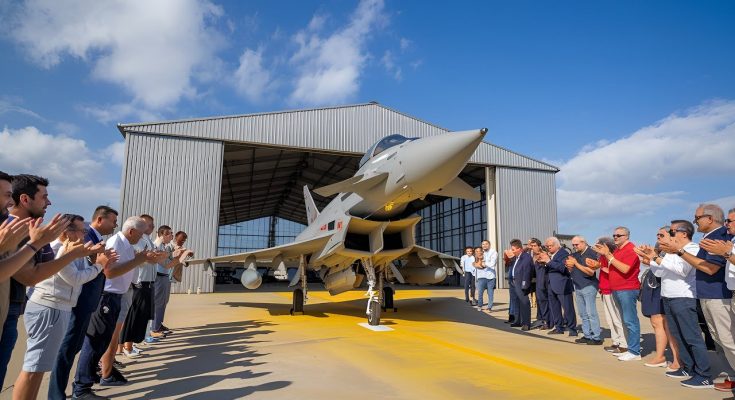Turkey’s Purchase of Eurofighter Typhoons: Strategic Shift and Geopolitical Implications
Turkey’s decision to purchase the Eurofighter Typhoon, one of the most advanced multi-role fighter jets in the world, marks a significant shift in its defense strategy and reflects the country’s evolving geopolitical interests. This acquisition comes amidst growing tensions in the region, evolving security concerns, and a need to modernize Turkey’s air force with advanced technology. The decision also highlights the complex nature of Turkey’s relationships with its NATO allies and other global powers.
The Context of the Purchase
Turkey has long been a member of NATO and has traditionally relied on U.S. military technology, particularly the F-16 Fighting Falcon, as the backbone of its air force. However, the dynamics of international relations have changed, and Turkey’s defense procurement strategy has evolved accordingly. A key turning point occurred in 2019 when the U.S. expelled Turkey from the F-35 Joint Strike Fighter program due to Ankara’s decision to purchase the Russian-made S-400 missile defense system. The U.S. viewed this as a direct security risk, as the S-400 could potentially compromise the stealth capabilities of the F-35 and provide Russia with sensitive intelligence on NATO technologies.
As a result, Turkey was left seeking alternative options to modernize its air force and maintain a competitive edge in the face of regional threats. The Eurofighter Typhoon, produced by a consortium of European aerospace companies (BAE Systems, Airbus, and Leonardo), emerged as a potential solution. The Typhoon, a fifth-generation multi-role fighter, is renowned for its agility, advanced avionics, and versatility in air-to-air and air-to-ground combat.
Why the Eurofighter Typhoon?
The Eurofighter Typhoon stands out as one of the most capable aircraft in the world, with an advanced design that allows for superior maneuverability, high-speed performance, and powerful sensor systems. The Typhoon has been in service since the early 2000s, and it has been continuously upgraded with state-of-the-art technology, making it a formidable competitor to other fighter jets, including the U.S.-made F-35 and F-22.
For Turkey, the Eurofighter Typhoon offers several advantages. Firstly, it provides an immediate solution to Turkey’s need for modern fighter jets, something the F-35 was supposed to fulfill. Additionally, by purchasing the Typhoon, Turkey strengthens its military cooperation with European countries, particularly the U.K., Germany, and Italy, which are all part of the Typhoon consortium. This deal could open doors to greater collaboration on defense projects and strengthen Turkey’s position within European defense initiatives.
The Typhoon’s combat capabilities make it a suitable replacement for aging aircraft in the Turkish fleet. Its versatile weaponry, advanced radar, and multi-role functionality allow it to conduct air superiority missions, precision strikes, and ground support operations, making it a crucial asset for Turkey’s defense needs.
Geopolitical and Strategic Implications
Turkey’s purchase of the Eurofighter Typhoon is not only a military decision but also a geopolitical one. By turning to European defense contractors, Turkey signals a diversification of its defense suppliers. This move also reflects Turkey’s increasingly independent foreign policy, as it seeks to reduce its reliance on the United States and NATO while exploring closer ties with Russia, especially after the S-400 deal.
The decision to purchase the Typhoon also has ramifications within NATO. While Turkey remains a key member of the alliance, its acquisition of Russian systems and a European jet may create friction with its NATO allies, particularly the U.S., which has expressed concerns about Turkey’s defense choices. The Eurofighter purchase could further strain relations with Washington, especially if Turkey’s growing defense ties with Russia continue.
At the same time, the Typhoon deal enhances Turkey’s position in the Middle East and beyond. As a regional power, Turkey’s military strength is essential for asserting influence, particularly in conflict zones like Syria and Libya. The Typhoon’s advanced capabilities give Turkey greater flexibility in addressing both traditional and emerging security threats, from air defense to countering missile attacks.
Future Prospects and Challenges
Turkey’s acquisition of the Eurofighter Typhoon is a significant step in modernizing its air force and diversifying its defense partnerships. However, there are challenges ahead. Integrating the Typhoon into Turkey’s existing fleet of F-16s and the S-400 missile system will require careful coordination to ensure interoperability. Additionally, maintaining the long-term viability of this acquisition will depend on continued support and cooperation with European partners, as well as navigating the complex political landscape of Turkey’s defense relationships.
Furthermore, Turkey’s decision to pursue indigenous defense technology, including the development of its own fighter jet, the TF-X, suggests that its long-term strategy involves increasing domestic production and reducing reliance on foreign systems. The Eurofighter purchase could be seen as an interim solution while Turkey works toward achieving greater self-sufficiency in defense technology.
Conclusion
Turkey’s purchase of the Eurofighter Typhoon marks a significant moment in its military history, highlighting a shift in its defense procurement strategy and an evolving approach to international relations. As Turkey navigates a complex geopolitical environment, the Typhoon acquisition reflects both its need for advanced military capabilities and its desire to assert greater independence on the global stage. While this deal strengthens Turkey’s defense posture, it also underscores the challenges of balancing relationships with NATO, Russia, and Europe in an increasingly multipolar world.



